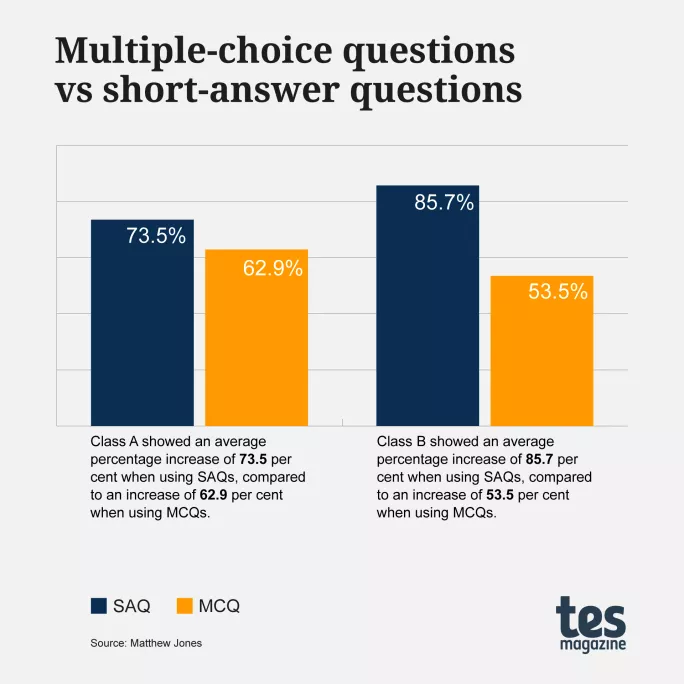- Home
- Teaching & Learning
- Secondary
- What’s the best way to check for understanding?
What’s the best way to check for understanding?

When it comes to measuring levels of understanding in the moment, multiple-choice or short-answer questions are popular solutions.
Both have their limitations: multiple-choice questions give a one-in-four chance to guess the correct answer, and, if short-answer questions are answered on mini whiteboards (as is often the case), it’s all too easy for students to glance at their neighbours’ boards if they become stuck. As teaching strategies, however, both are cost- and time-effective.
But which has the greater impact on student attainment? I decided to undertake some action research to find out.
Over two months, I compared the use of short-answer questions (SAQs), and the use of multiple-choice questions (MCQs) in two mixed-ability Year 7 maths classes.
After carrying out a literature review to ensure the interventions I carried out were grounded in good practice, I taught each class two topics: equations of lines and fractions.
For class A, I measured progress using MCQs for fractions and SAQs for equations of lines. For class B, I used SAQs for fractions and MCQs for equations of lines. Both strategies were used within each lesson as a learning check before independent practice.
- DNA prediction is here - so what are schools going to do about it?
- How to support Roma pupils in school
- School choice: Do Ofsted judgements really matter?
MCQs were delivered via Google Forms in each class’s Google Classroom, which pupils accessed through our class set of iPads. The Google Form entailed five questions, each with four possible answers. Each incorrect answer was based on a potential misconception.
For SAQs, I used the whiteboard feature on the online mathematical website DrFrostMaths. This is software that transforms individual hand-held devices, such as iPads, into whiteboards. The students write their answers on their digital whiteboard, and these answers are all sent to the teacher’s device. The teacher can write and model answers live on their digital whiteboard and it will be replicated on all students’ whiteboards.
Both classes completed a pre-topic assessment for each topic, but no feedback was given. At the end of each topic, students repeated the assessment. This allowed me to compare the best strategy for each class, but also the best strategy for each topic.
Students who completed both the pre-topic assessment and the post-topic assessment also completed a questionnaire, with a range of open and closed questions, asking them about their experiences of using both approaches.
So what did I find? Well, across both classes and topics, there was a larger improvement in assessment scores when using SAQs compared to MCQs.

For equations of lines, Class A improved 20 per cent more than Class B, whereas for fractions, Class B improved 22.8 per cent more than Class A. This suggests that using SAQs can improve progress by an extra 20 per cent than using multiple choice questions.
Results from the questionnaire also demonstrated that students preferred SAQs; this approach scored higher than MCQs in both an enjoyment rating and an effectiveness of learning rating. It’s also the strategy that more students said they would like to see used in future lessons.
Overall, my results showed SAQs to be the more effective learning check. However, this was only a small-scale piece of action research, and I can’t say whether the results would be the same in another context - when working with a different age group, in a different subject or in a different type of school.
It’s also worth noting that the use of iPads may also have improved the effectiveness of both methods, giving independent routines for the students, while providing teachers with feedback that could be used to guide future lessons.
What, then, will I take away from this project?
I have now tailored my approach in almost all lessons to include some style of SAQs as a learning check, which has been made considerably easier through the use of hand-held devices within the classroom. It is, however, important to use this alongside other methods, such as using MCQs or Think Pair Share, to keep learners engaged.
Matthew Jones is a maths teacher at Windsor High School and Sixth Form in Halesowen, which is part of the Windsor Academy Trust
Register with Tes and you can read two free articles every month plus you'll have access to our range of award-winning newsletters.
Keep reading with our special offer!
You’ve reached your limit of free articles this month.
- Unlimited access to all Tes magazine content
- Save your favourite articles and gift them to your colleagues
- Exclusive subscriber-only stories
- Over 200,000 archived articles
- Unlimited access to all Tes magazine content
- Save your favourite articles and gift them to your colleagues
- Exclusive subscriber-only stories
- Over 200,000 archived articles
topics in this article



